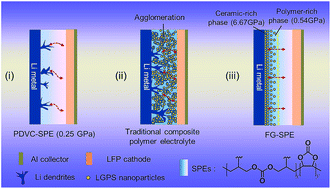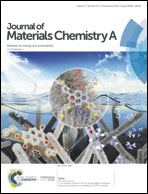A functional-gradient-structured ultrahigh modulus solid polymer electrolyte for all-solid-state lithium metal batteries†
Abstract
There is a contradiction between achieving a high modulus solid polymer electrolyte (SPE) and good interface contact in all-solid-state lithium metal batteries to prohibit the dendrite growth and increase the cell cyclability, respectively. Herein, we report a new functional-gradient-structured ultrahigh modulus SPE (FG-SPE) by integrating a ceramic-rich phase and polymer-rich phase. The ceramic-rich phase physically prohibits the dendrite growth, while the polymer-rich phase improves the interface compatibility between the cathode and electrolyte. As a result, this ultrahigh modulus solid polymer electrolyte renders a low charging voltage polarization of 0.5 mA h cm−2 for FG-SPE-based symmetrical batteries. All-solid-state Li/LiFePO4 batteries based on this material show a high specific capacity of 163.2 mA h g−1 at 0.1C, and a high reversible capacity could still be obtained even at a rate of 2C. Importantly, the active material could achieve a high mass loading of 15.6 mg cm−2, which is significant for practical applications.



 Please wait while we load your content...
Please wait while we load your content...